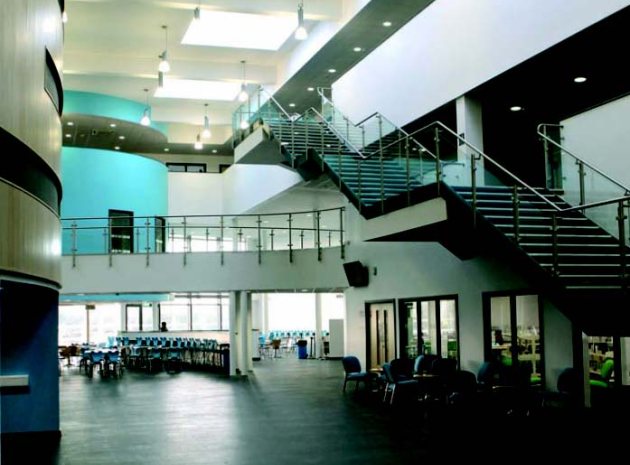THE SCHOOL LEADER: Claire Smith is principal of the Bedford Academy, which moved into brand new buildings on November 5th this year
“Our vision for Bedford Academy revolves around the concept of ‘learning villages’; the brand new school building with its ‘hub and spoke’ design brings this vision to life, by featuring a central hub that leads into four individual spokes, each one housing a learning village, and a penthouse-style third storey area that accommodates a fifth. Led by the senior management team, each learning village offers students specialist subject teaching as well as important pastoral care and, with a special area dedicated to each one, students and staff are really able to take ownership of their learning space.
Certainly it is possible to make an existing building fit around a vision for a school, as we have done for the past two years, but the government’s plans to limit the designs for new builds will restrict schools from creating unique learning spaces that truly reflect their educational ethos. The proposed restrictions would for us have restricted innovative features such as multi-purpose ‘triangular’ corridors, for example, which are proven to greatly enhance quality teaching and learning. I accept that cuts need to be made, but let’s not split new schools set up to improve learning and teaching, from building learning spaces that reflect their inspirational role and ethos.”
THE ACADEMIC: Professor Ruth Reed is director of professional studies at Birmingham City University’s School of Architecture, and a former president of RIBA
“There’s no problem with having generic solutions (and indeed, exemplar schemes were an important feature of the BSF programme), but the concern is that these new templates seem to have unlearnt some of the things that had previously been identified in terms of what makes a good teaching environment. The agenda when drawing them up has been entirely cost driven – of course, architectural design is always contingent on money, but in the process of reducing budgets, it’s far from clear whether or not the right things have been left in.
For example, in order to reduce floor space, the width of circulation areas has been reduced; but we know that this can increase the risk of bullying, which is something that can have a long-term impact on students’ achievement. The lack of extendibility could be a problem in the future, as there is a bulge in the primary population at the moment, which will need accommodating within existing secondary schools at some point. And we have a wonderfully integrated education system in this country that is recognised for its inclusivity throughout the world and in which disabled pupils are valued equally with their able-bodied peers – but if new environments are not entirely accessible, then this could be at risk.
The truth is, no architect designs something for his or her own benefit. We are always charged with realising the client’s vision, so if schools built over the next couple of years prove to be inadequate for improved teaching and learning in the long term, it will be because the client had other priorities.”
THE DESIGNER: Ian Watts is the principle designer at McAndrew Watts Architecture and Interior Design Consultants (mcandrewwatts.com)
“It’s disappointing that the government should have to consider resorting to these kinds of measures to resolve a matter that should be dealt with by the construction industry itself. Naturally it would be wrong to suggest that standardising designs and specifications wouldn’t drive down costs but this is most likely to be at the expense of the quality of our learning environments.
There is a concern that applying a cookie cutter approach to new building also ignores other significant construction issues. Too often critical financial issues are caused by construction overspends due to inadequate site investigation, poor design and unfocused project management. In most cases the impact of these can significantly outweigh any savings generated by working to a specific template design.
Education is one of several sectors in which our practice works but as with any other, the financial aspect of every project has become more and more important. There needs to be a balance created between the need to deliver a good quality inspirational learning environment to a prescribed budget, and that of seeking design awards with a ‘money no object’ brief. In these times of austerity it is really down to the whole of the construction team to focus on delivering this.”










